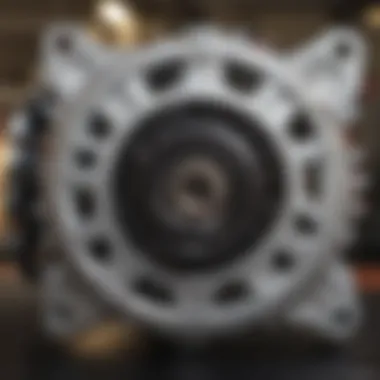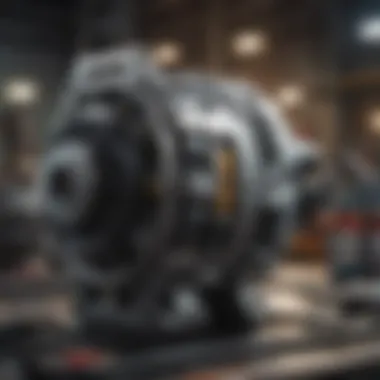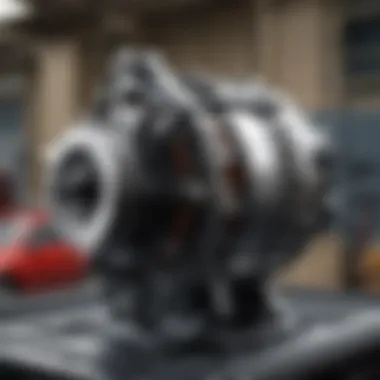2012 Chevy Traverse Alternator Replacement Cost Guide


Intro
In this guide, we present a detailed exploration of the alternator replacement cost for the 2012 Chevy Traverse. The alternator is vital for the proper functioning of a vehicle, as it recharges the battery and powers the electrical system while the engine runs. Understanding the replacement costs is crucial for vehicle owners, as there are various factors that impact the overall expense. These include the cost of the part itself, labor charges, and the unique characteristics of the vehicle. This article aims to provide a nuanced analysis to help you make informed decisions about your automotive repairs.
Factors Influencing Replacement Costs
When considering the cost of replacing an alternator, several key elements come into play:
- Part Quality: The choice between original equipment manufacturer (OEM) parts and aftermarket components can significantly vary the price.
- Labor Costs: Mechanic shop rates vary by location and expertise, impacting overall expenses.
- Additional Repairs Needed: Sometimes the repair might reveal underlying issues requiring further service.
These elements create a full picture required for intelligent automotive decision-making.
Comparing with Similar Vehicles
When costs rise for repairs, some may want to compare them against similar vehicles. The 2012 Chevy Traverse sits within a category with other mid-sized SUVs like the Honda Pilot and Ford Explorer. Though each has unique attributes, examining average replacement costs could provide context for decision-making.
Labor Costs
Labor contributes to the total cost of an alternator replacement. Typically, mechanics charge hourly rates that vary widely across the country. It is reasonable to expect around three to five hours for proper alternator removal and installation, which adds up quite fast.
Meanwhile, if you are handy, you could potentially perform the replacement yourself. This option could save significant amounts in labor costs.
Alternatives to Replacement
Not every scenario demands an alternator replacement. Sometimes, repair options may exist, such as:
- Electrical Inspection: Have a mechanic adequately diagnose the electrical system. Sometimes issues may be from faulty connectors or aging wiring rather than the alternator.
- Rebuilding the Alternator: Some shops offer rebuilding services instead of full replacements, which can be more affordable.
Gaining insights into alternatives can help you mitigate costs without losing functionality.
Ending
The expenses tied to alternator replacement are indeed multi-faceted. By considering part quality, labor charges, and alternative solutions, you can navigate the financial burden effectively. As owners of a 2012 Chevy Traverse, remaining well-versed in these elements will permit informed decisions surrounding comprehensive vehicle health and longevity.
Prolusion to the Chevy Traverse
The 2012 Chevy Traverse, a midsize crossover SUV, has gained popularity for its functionality and dependability. Understanding its specifications and mechanical function is crucial when examining aspects like the alternator replacement cost. Not only does this knowledge aid in making informed decisions, but it also emphasizes the importance of regular maintenance and aware car ownership. The Traverse's intricate systems work in unison, and the alternator is a key element of that mechanism.
Overview of Vehicle Specifications
The 2012 Chevy Traverse boasts a V6 engine, offering a balance of power and fuel efficiency. With a capacity to hold up to seven passengers, it often stands out in its class. Notably, the standard equipment encompasses key safety features, ample cargo space, and advanced technology options.
Specifications Include:
- Engine Type: 3.6L V6
- Horsepower: 288 hp
- Torque: 270 lb-ft
- Fuel Economy: Approximately 16 city / 23 highway miles per gallon
- Cargo Capacity: 116.3 cubic feet with rear seats down These features augment both comfort and performance, reinforcing the necessity of vital components like the alternator that keeps electrical systems activated and running smoothly.
The Role of the Alternator in the Vehicle
The alternator serves a fundamental role in the vehicle's electrical system. It transforms mechanical energy into electrical energy, recharging the battery and powering all electrical devices while the vehicle is operational. A malfunctioning alternator does not only lead to difficulty starting the vehicle, but it can also result in multiple electrical failures.
An adequately functioning alternator supports:
- Battery Life: Ensures the battery stays charged and functions properly.
- Electrical Systems: Powers headlights, radio, and onboard systems while driving.
- Operating Systems: Supports critical systems like the anti-lock braking system and the fuel system.


Without the alternator's contributions, overall vehicle performance can deteriorate. Hence, understanding its significance is imperative to identity issues that could lead to costly repairs or safety concerns down the line.
Essential Point: Being aware of the alternator’s role can save car owners time and money. Regular checks monitor its condition and functionality, which forms part of a diligent preventive maintenance routine.
Understanding Alternator Failure
Recognizing alternator failure is a crucial step in maintaining the functionality of your 2012 Chevy Traverse. An understanding of how the alternator operates, its role in the vehicle, and the primary concerns will help you act proactively in repairs. Knowing the symptoms can prevent further damage the vehicle and save money in repair work.
Common Symptoms of Alternator Problems
Identifying the symptoms of alternator problems early can save time and expenses. Here are several common indicators:
- Dim or Malfunctioning Lights: If headlights or dashboard lights flicker or become dim, it might signal an alternator issue.
- Electrical Accessory Failure: If power windows, radio, or seats are sluggish or unresponsive, this could be a sign of alternator trouble.
- Warning Light on the Dashboard: The battery or charging system warning light could illuminate due to alternator issues, urging immediate investigation.
- Dead Battery: If the battery repeatedly dies, the alternator may not be charging it properly.
- Strange Noises: Unusual noises such as whining or grinding might indicate loose or failing components in the alternator.
Addressing these symptoms right away is vital to prevent further complications. Monitoring the electrical system proves beneficial for keeping your Chevrolet Traverse operating smoothly.
Root Causes of Alternator Failure
Understanding why an alternator fails can help you take proactive measures to extend its lifespan. Below are the primary causes of alternator failure:
- Worn-Out Bearings: Bearings in an alternator can wear out over time due to friction and age, leading to malfunction.
- Faulty Voltage Regulator: The voltage regulator is responsible for maintaining proper voltage levels. If this component fails, it can lead to overcharging or undercharging.
- Damaged Diodes: Diodes convert AC to DC power. Damaged diodes can lead to poor performance of the entire unit.
- Corrosion or Loose Wiring: Poor connections can lead to corrosion that interferes with the alternator’s ability to charge the battery properly.
- Extreme Operating Conditions: Operating your vehicle in extreme weather or continuously under heavy load, like towing, can affect alternator efficiency and durability.
Understanding alternator failure mechanisms equips you to make informed decisions regarding repairs or replacements, which can ultimately safeguard your financial interests when dealing with auto expenses.
Cost Factors Associated with Alternator Replacement
Understanding the cost factors associated with alternator replacement in a 2012 Chevy Traverse is essential for vehicle owners. Having this knowledge can aid in budgeting and make informed decisions. Various elements influence the total expenses, including parts, labor, and potential regional differences. Knowing these factors can also highlight any opportunity for cost savings or areas where one might not have considered additional expenses.
Parts and Labor Breakdown
The financial investment for replacing an alternator generally consists of parts costs and labor expenses. Each component has a significance.
- Parts: The average cost of the alternator for a 2012 Chevy Traverse can range significantly, typically between $150 to $400. The price disparities occur due to differences in brand, the quality of the part, and warranty factors.
- Labor: Mechanic fees may vary as well. On average, labor costs can stem from $75 to $150 per hour. The duration for the task can differ based on the mechanic’s efficiency and overall vehicle condition, generally taking about 2 to 4 hours to complete, resulting in labor costs of approximately $150 to $600.
Combining parts and labor, the general total replacement cost for this task can range from $300 to $1,000. Clearly, understanding these elements helps the owner align their expectation with reality.
Regional Variability in Costs
Absorbing the costs can unveil regional differences, often influencing the repair expenses. Depending on geographic location, costs may see marked changes.
- High-Cost Areas: In urban locations, markets tend to reflect higher expenses due to increased overhead for services as well as demand for skilled mechanics.
- Rural Areas: Comparatively, service costs in rural areas may present lower pricing. However, limited repair shops can impact the availability of quality service options.
These variances illustrate that not only mechanical knowledge is crucial, but cost knowledge enhances one's negotiating stance in front of repair shops.
A profound understanding of cost factors offers vehicle owners an advantage in managing expenses, ensuring their budget hits the targets committed to maintaining their Chevy Traverse.
Average Replacement Cost for Chevy Traverse
Understanding the average replacement cost for the 2012 Chevy Traverse's alternator is crucial for budget-conscious vehicle owners. Knowing the potential financial implications associates enhances awareness when addressing alternator issues. The alternator, a key component in the vehicle's electrical system, has replacement costs that vary. Engaging in replacement discussions will help to minimize out-of-pocket expenses considerably in long run.
Considerations about factors influencing pricing could significantly impact consumers' decisions. When automobile owners are informed, they can effectively plan for repairs. The nuances can guide which choices are best, whether tackling repairs face, considering professional assistance, or exploring warranties and guarantees.
Nationwide Averages
A general rule for replacement costs across the country offers insight. The average national cost for a 2012 Chevy Traverse alternator replacement ranges from $400 to $800. This cost generally covers both parts and labor, an essential metric for budget evaluation.


Relevant factors include:
- Parts: Replacement alternators can cost between $200 to $500, depending on brand and location.
- Labor: Technicians typically require 2 to 3 hours for installation, leading to labor costs ranging between $100 to $300.
Many passengers vehicles congregate around this price point when comparable requirements for reliability and performance are established.
Comparison with Similar Vehicles
When analyzing alternator costs, comparing the 2012 Chevy Traverse to similar mid-sized SUVs or crossovers proves beneficial. The Ford Explorer and Honda Pilot average about $450 to $760 for their alternator replacements. These prices share common ground with the Traverse, indicating that this model aligns comparably well within its segment.
Consider factors such as:
- Manufacturing Specifications: Different models employ varying components. That's why some SUVs cost a bit more to repair than others.
- Market Trends: Regional differences can emerge based on local supply and demand, so being active in observing trends can aid future maintenance and repairs.
- Condition of Vehicle: Interaction between the vehicle itself, including age and operating condition, can lead to unforeseen bulky repairs.
The awareness of these cost averages informs decision-making and paves clear paths towards ensuring ultimate representational values in automotive efforts.
DIY vs.
Professional Replacement
When considering the replacement of the alternator in a 2012 Chevy Traverse, one of the pivotal questions revolves around whether to undertake the task as a DIY project or to engage a professional mechanic. This choice significantly affects not just the financial implications but also the overall outcome of the repair. Understanding both angles is fundamental for any Traverse owner facing alternator issues.
Advantages of DIY Replacement
Opting for a DIY approach to alternator replacement can offer several benefits, chiefly related to cost savings and personal empowerment.
- Cost Savings: Generally, executing a replacement yourself can minimize the associated labor fees charged by professionals. Depending on local rates, mechanic fees can quickly elevate the total bill.
- Skill Development: Engaging in a DIY project can enhance your technical ability, giving you a clearer understanding of vehicle mechanics. This knowledge may prove valuable for future repairs, potentially cultivating a broader automotive skill set.
- Control Over Quality: By performing the task yourself, you can select the quality of parts you wish to use. Using premium components may enhance durability and performance, something that might not always be obtained in a professional setting.
- Satisfaction: Successfully completing a significant car repair brings a sense of accomplishment. For many, knowing that they have tackled the problem themselves is fulfilling in ways that a simple trip to the service shop may not be.
It is essential to note, however, that not every individual possesses the confidence or ability needed for such tasks. Moreover, lacking tools suitable for the job may result in unforeseen expenses.
When to Seek Professional Help
While DIY can be valuable, there are moments when hiring a professional mechanic is the wiser choice. Some situations necessitate trained expertise to ensure the safe and effective completion of alternator replacement.
- Lack of Experience: If one lacks experience with automotive repairs, attempting a replacement could lead to mistakes. Complex components in the alternator system require proper handling, and errors can escalate into serious damage, leading to higher repair costs.
- Missing Tools: Many DIY projects require specific tools that one might not own. Purchasing high-quality tools can sometimes result in expenses that exceed the cost of hiring a professional from the start.
- Time Constraints: For those with busy schedules, the time required for a do-it-yourself job can be a significant factor. Professionals generally complete repairs efficiently due to their experience, thereby saving the car owner time.
- Warranties and Guarantees: Engaging a professional service may sometimes come with warranties or guarantees for parts and labor. This coverage offers an added layer of protection, ensuring that if issues arise soon after replacement, the costs could be mitigated.
Overall, the decision between DIY and professional replacement hinges on several factors, including budget, skill level, and available resources. Weighing these elements ensures that Traverse owners make informed choices whether they attempt the repair themselves or seek professional assistance.
Both DIY and professional options carry their own merits. Assess your personal skills and circumstances to make the best decision for your vehicle's needs.
Alternator Replacement Process Explained
Understanding how to replace the alternator on a 2012 Chevy Traverse is crucial for any vehicle owner concerned about performance and reliability. The alternator plays a vital role in the electrical system by keeping the battery charged and powering components. Knowing how to properly execute this process not only ensures a functioning vehicle but can also save significant costs that come with professional labor fees. In this section, we will outline the tools needed and provide a straightforward guide for replacing the alternator.
Tools Required for Replacement
Before beginning the replacement, it is essential to gather the necessary tools. This can make the process smoother and more efficient. Here is a brief list of tools that will be needed for the job:
- Socket Set: A range of metric sockets helps fit various bolts.
- Wrench Set: Necessary for loosening any nuts that may be difficult to reach.
- Screwdriver Set: Flat and Phillips screwdrivers are often useful when dealing with electrical connections.
- Safety Glasses: For protection against debris.
- Torque Wrench: To ensure the bolts are tightened to the manufacturer's specifications.
- Pliers: Useful for pulling off connectors or other debris.
Step-by-Step Replacement Guide
Replacing the alternator might seem daunting, but by following a step-by-step approach, it can be accomplished systematically. Here’s a simplified guide to help navigate through the process:
- Safety First: Disconnect the negative battery terminal. This prevents accidental electrical shorts while working on the vehicle.
- Access the Alternator: Remove any components blocking access to the alternator, including belts or other pieces that may be in the way.
- Unplug Electrical Connections: Carefully disconnect any wiring harness attached to the alternator. Take note of their positions for reinstallation.
- Loosen the Mounting Bolts: Locate and loosen the bolts securing the alternator. Keep these bolts safe, as they will be used later.
- Remove and Replace: With the mounting bolts loosened, you can now remove the old alternator from its bracket. Insert the new alternator in its place and begin reinstalling the bolts.
- Reconnect Electrical Connections: Once secure, connect the wiring harnesses back to their respective terminals. Ensure that the connections are tight and secure.
- Reassemble Components: Reattach any components or belts that you had to remove for access.
- Reconnect Battery Terminal: Finally, reconnect the negative battery terminal.
- Test Run: Start the engine and ensure that the new alternator is functioning properly, with no warning lights on the dashboard.


Following these steps carefully will lead to a successful alternator replacement on your Chevy Traverse, while helping to avoid any potential mistakes from DIY repairs.
The effectiveness of this process lies in the proper execution of each step. While some might find the idea of replacing an alternator intimidating, with the right tools and guidance, it can be a manageable task even for those without extensive automotive knowledge.
Potential Hidden Costs
The subject of potential hidden costs in alternator replacement is significant in comprehensively understanding the financial implications of such an operation. Often, vehicle owners focus primarily on the visible costs like the price of parts and labor. However, hidden costs can emerge during the replacement process, leading to unexpected financial burden.
Hidden costs may include related repairs that are identified only once the alternator is accessed. Components like belts, wiring, or even the battery might also require attention. If these elements are worn or damaged, they can affect the performance of the new alternator. Paying attention to these issues during the alternator replacement can prevent quality problems and assurances about the health of the whole electrical system.
Additionally, if the installation shows that previous repairs were inadequate, more expenses can arise. These surprises can lead to further downtime for the vehicle, complicating the owners' plans. A thorough understanding of these potential issues can save hassle down the line. In general, it's best practice to assess the full scope of repair issues during a major service such as alternator replacement.
Related Repairs and Their Costs
Related repairs can include various components of your electrical system. Specifically:
- Battery: A worn battery may not hold charge effectively, especially with new alternator.
- Belts: Worn serpentine or drive belts should be replaced to avoid alternator strain.
- Wiring: Any fray or damage to wiring may compromise power flow.
- Fuses and Relays: These often need checking as improper function can lead to additional failures.
Repairing these issues often costs anywhere from $50 to $300, depending on parts and labor involved.
Warranty Considerations
Considering warranties is another critical aspect when it comes to alternator replacement. Many replacement parts come with a warranty, which typically ranges from one to three years.
- Check the warranty policy carefully; it often outlines whether you are covered for labor and parts.
- In some cases, if the newly installed alternator proves defective, having a warranty can reduce costs related to its replacement.
- Always keep records of work completed on your vehicle, as this may be essential for claiming warranty benefits.
Taking note of these costs, repairs, and warranty implications can significantly influence the overall expenses associated alongside alternator replacement.
Aftermath of Alternator Replacement
The aftermath of alternator replacement is a crucial phase that many car owners often overlook. After the new alternator is installed, it is essential to ensure it operates correctly. This section furthers understanding on the importance of testing and maintaining the electrical system in a 2012 Chevy Traverse, ensuring it serves the vehicle well for an extended period.
Testing the New Alternator
Once the new alternator is in place, testing its functionality is vital. Here are some steps to follow:
- Visual Inspection: Ensure all connections are secure and that there are no signs of damage or wear.
- Start the Engine: A functional alternator should easily start the engine without any struggle.
- Voltage Measurement: Use a multimeter to check the voltage output. A healthy alternator should produce between 13.5 and 14.5 volts at idle.
- Load Test: Turn on electrical components like headlights, air conditioning, and radio. The voltage should remain steady. If you observe dips below 12 volts, it may indicate an issue.
- Check Warning Lights: Ensure that the battery warning light on the dashboard does not illuminate, as this could suggest a malfunction.
Regular testing is essential to prevent future problems. If detection of issues occurs, revisiting the installation process or consulting a professional may be needed.
Maintaining the Electrical System
Maintaining the electrical system is equally important for long-term vehicle health. The alternator is just one part of a broader electrical system, and care must be taken to keep everything running smoothly. Consider these maintenance tips:
- Periodic Inspections: Conduct routine checks on the battery, wiring, and fuses to catch problems early.
- Keep Connections Clean: Corroded connections can hinder performance. Cleaning terminals and connectors helps ensure good conductivity.
- Check Battery Health: A weak battery can put undue stress on the alternator. Test and replace the battery if necessary.
- Monitor for Unusual Sounds: Noises from the alternator could signify issues requiring immediate attention.
- Avoid Electrical Overload: Unnecessary electrical accessories can strain the alternator. Use them judiciously.
Testing a new alternator and maintaining the electrical system are fundamental. Strong specific attetion is key in this process to prevent future breakdowns and costs associated with repairs. Ensuring optimal functioning contributes to a smooth driving experience.
Ending
The importance of understanding the cost associated with replacing the alternator for a 2012 Chevy Traverse cannot be overstated. Awareness of both parts and labor expenses assists car owners in comparing options effectively. Traditional mechanics might present a different set of rates, which can vary significantly based on region and specific shop charges. Furthermore, realizing that the alternator is a crucial component of the vehicle’s overall electrical system highlights the necessity of maintaining its functionality.
Cost analysis sheds light on potential alternatives to direct replacement, such as refurbishment or upgrading to a higher-performance unit. Each of these options has distinct advantages.
Final Thoughts on Costs and Alternatives
Navigating the costs tied to alternator replacement can be complex. When considering a replacement, ensuing costs aren't limited to the alternator itself. Here are aspects that vehicle owners should keep in mind:
- Regional Differences: The labor rate differs greatly in various geographic locations, affecting the overall expense.
- Parts Quality: Aftermarket versus original equipment manufacturer (OEM) parts carry king sized price variations and durability considerations.
- DIY vs. Professional: Although DIY work costs less in labor, it requires tools and potentially hidden pitfalls during installation.
- Related Repairs: Often, a failing alternator can indicateissues with the battery or other electrical components. Assessing related costs at the same time can be prudent.
Assessing these aspects mindfully guides owners toward sound financial decisions while accounting for their vehicle’s health, which ultimately yields greater satisfaction and reliability.







